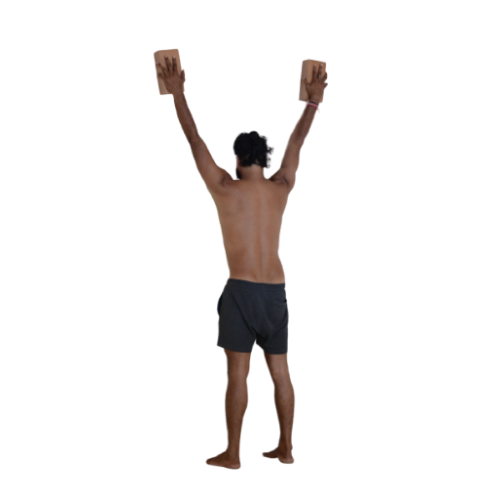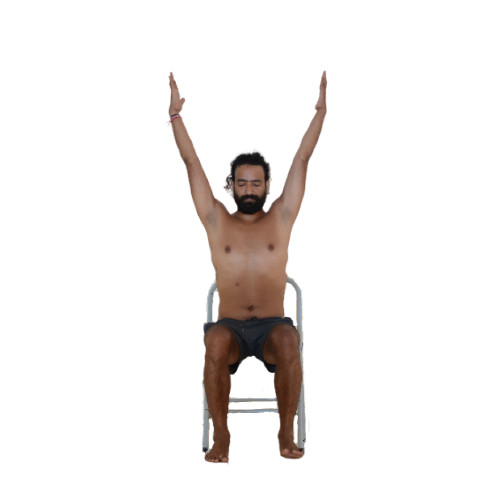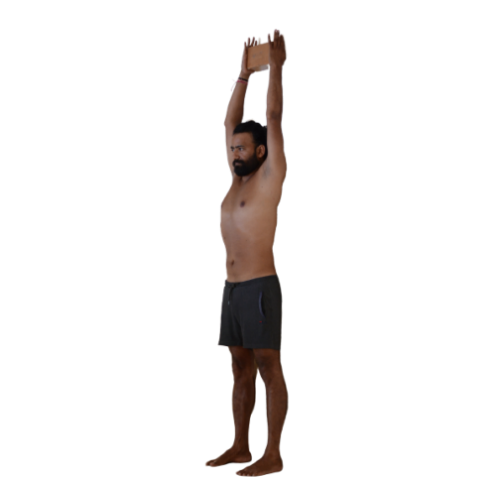From Sanskrit to English
Sanskrit pronunciation: Urdhva Hastasana (oord-vah hahs-TAHS-anna)
Meaning: urdhva = upward, raised; hasta = hand
Urdhva Hastasana, also called Talasana (Palm Tree Pose) or Urdhva Namaskarasana (Upward Prayer Pose), is most commonly known in English as Upward Salute, Upward Hand Pose or Volcano Pose. Given that its foundation is Tadasana, it is sometimes referred to as Mountain Pose with Arms Over Head.
Benefits of the Urdhva Hastasana pose
+ Stretches and lengthens the entire body
+ Strengthens the posterior chain muscles
+ Prepares the spine for deeper backbends and twists
+ Opens the entire front torso
+ Improves alignment, balance, and digestion
+ Relieves backache, anxiety, fatigue, asthma, and congestion
+ Energizes the body and awakens the mind
Yoga for every BODY
Part of the Surya Namaskar (Sun Salutation), Urdhva Hastasana offers an entire body stretch and serves as an excellent warm-up for more intense yoga poses. While it is accessible to most people, it is not as simple as it appears to be. Indeed it uses the fairly refined alignment of Tadasana with the additional raising of the arms overhead. So if your balance is uneven and/or your shoulders are tight and/or your neck is stiff, Urdhva Hastasana may be a bit of a challenge. That’s why we have prepared a series of modifications for you to adapt the pose to your current needs.
Standard Urdhva Hastasana
1. Stand in Tadasana with your feet together. If needed, move your heels slightly apart so that the outer edge of your feet are parallel.
2. Pressing into the four corners of your feet, micro-bend your knees and engage your legs; squeezing your knees together, lifting your knee caps towards your thighs, and rolling your inner thighs slightly inwards.
3. Activate your mula bandha (root lock) and uddiyana bandha (abdominal lock). Raise your arms straight up in front of you to form a 90 degree angle, retract the arm bones into their sockets, and turn them towards one another so that your palms can face each other.
4. Push your thighs back, rolling them slightly inward, straighten your knees and send your heels towards the floor.
4. Engage your oblique muscles to draw your rib cage slightly inwards (towards the midline) and down (towards your pelvis), lengthen your tailbone towards your heels, and slowly sweep your arms further up to the sky.
5. Keeping the shoulders away from the ears, extend your elbows fully, bring your palms together with your fingers stretched, and gently tilt your head back to gaze at your thumbs.
Modification 1: Blocks on a wall
Using blocks and a wall to support your body will help you find the correct alignment. Keeping the legs a little wider than hip-distance is great if you suffer from backache or knee pain. Opening the arms will prevent the elbows from bending and the shoulders from rising.
A

1. Grab two blocks and stand in Tadasana in front of a wall, with your feet a little wider than hip-distance, toes pointing towards the wall.
2. Holding one block in each hand, keep your arms alongside the body with the blocks facing towards the wall.
3. Place the blocks against the wall, and slowly slide the blocks up to raise your arms towards the sky. Only lift your arms as high as is comfortable, making sure that your arm bones remain into the sockets and that your neck isn’t being compressed.
4. Rest your forehead on the wall.
Modification 2: Sitting on a chair
If standing up straight is challenging, you can sit on a chair. You will still be able to understand the actions required both in the lower body and in the upper body.
B

1. Sit on a chair with your feet hip-distance apart.
2. Press into the four corners of your feet, engage your shins, knees, and quadriceps muscles.
3. Activate your mula bandha and uddiyana bandha. Drawing your rib cage slightly inwards and down, lengthen your tailbone towards the floor.
4. Turn your arms outward and raise them so that your palms can face each other but keep them further apart than shoulder distance. Extend your elbows and fingers.
5. With your head in line with your back, close your eyes to feel the alignment.
Modification 3: Squeezing a block
Squeezing into a block will help you find strength in the legs and prevent your thighs from turning out. In Urdhva Hastasana, the dual action of the inner thighs rolling inwards and the tailbone lengthening towards the floor is key because it is what allows us to neutralize the pelvis.
C

1. Place a block on its narrow side between your inner thighs, close to your pubic bone.
2. Micro-bending your knees, lift your toes and firm your thighs around the block. As you stretch your toes back onto the floor, engage your shins, lift your knee caps, and roll your inner thighs slightly inwards – as if you were trying to send the block behind you.
3. Activate your mula bandha and uddiyana bandha. Drawing your rib cage slightly inwards and down, lengthen your tailbone towards the block.
4. Turn your arms outward and raise them so that your palms can face each other but keep them further apart than shoulder distance. Extend your elbows and fingers.
5. With your head in line with your back, close your eyes to feel the alignment.
Modification 4: Using a wall and a block
Holding a block between the hands and using a wall to support the back body will help you draw your shoulders away from the ears, and become mindful about your ribcage.
D

1. Grab a block and stand in Tadasana, feet hip-distance, and your entire back body touching the wall.
2. Follow the instructions for Standard Urdhva Hastasana, holding a block on its longer side between your hands. Instead of looking up, send your gaze forward.
Modification 5: Pushing into blocks
Squeezing a block between your feet and a block between your hands gives you something to push into, enabling your body to understand the alignment required both in the lower body and in the upper body.
E

1. Place a block on its narrow side between your feet and hold a block on its longer side between your hands.
2. Follow the instructions for Standard Urdhva Hastasana, holding a block on its longer side between your hands. Instead of looking up, send your gaze forward.
Modification 6: Securing the arms
As the arms get closer, the tendency is for the elbows to bend. To prevent this from happening you can use a strap to secure your arms.
F

1. Loop a strap and slide into it with your arms, placing it right above the elbows and tightening it so that your arms cannot move more than shoulder-distance.
2. Follow the instructions for Standard Urdhva Hastasana. The strap may get in the way of your head, but you can slide under the strap so that it supports the back of your head.
Interested in becoming a yoga teacher?
Newsletter
Upcoming events and latest blogs